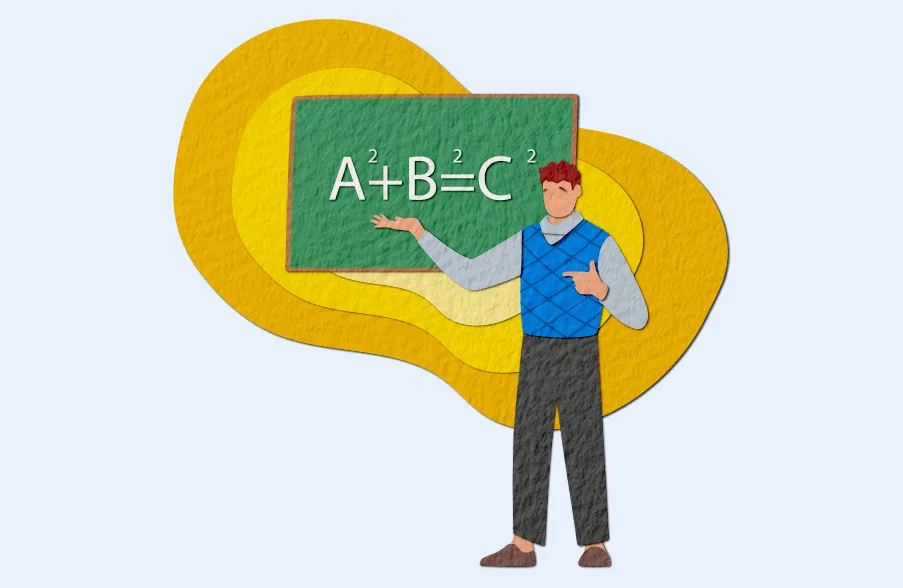Just as there are principles that serve as the foundation for every level of mathematics, so, too, are there common strategies that can help in any math substitute teaching assignment.
First, it’s important to follow two guidelines that will help keep you on track:
- Stick to the lesson plan that the absent teacher provides
- Follow the absent teacher’s routine, which, ideally, will be outlined in the day’s sub plans
With that in mind, let’s dive into a few other strategies to help the next time you sub in a math class.

Embrace a confident mindset
It’s important to exude an aura of confidence when teaching your own class, and this is still true when you’re filling in for another teacher. When you’re subbing in a math classroom, it can be much easier to feel confident if math education is in your wheelhouse, but even if it’s not, there’s no need to discount your knowledge to your students. Avoid making comments like, “I’m not a math person,” and instead project confidence and competence.
If you’re not quite comfortable explaining the “whys and hows” of math concepts, another helpful tip is to understand that your role is that of a facilitator or guide, not the source of all answers. There’s a good chance that a student might have a question for which you don’t have an immediate answer — in fact, you should expect it! It’s okay to not know everything so just be honest!
Be prepared
As you would for any substitute assignment, get there early so you have time to prepare. Get a sense for the flow of the lesson and whether you’ve been asked to introduce any new material. Remember that the full-time teacher knows that you might not be an expert on the subject! See whether students are supposed to work on assignments together or on their own.
Many math teachers have “emergency assignments” or activities ready to go in case they need to miss a day that give students something of educational value in case a substitute doesn’t feel confident to step in at the current point in the sequence of topics. Try to determine whether the assignment is of this nature, or whether it’s simply picking up from where the last lesson left off. If this isn’t clear, see if you can find another grade-level math teacher who would know, or ask the class what they worked on during the previous class.
Potential challenges
There’s a very good chance that students will ask you questions that they can answer themselves with some thought or collaboration with other students. If you do know the answer, giving it away deprives students of a valuable learning moment. Instead, ask them to take out their notebooks/notes and consider what they’ve recently learned in class, and whether they can relate it to what they’re working on now.
Students are now expected to go beyond just “getting the answer” and are expected to explain their reasoning as they learn math concepts. If students aren’t already working in groups, ask nearby students if any of them can help the student with the question.
Everybody benefits from this, since the students giving help and explanations are strengthening their understanding. If students are in groups and a group has a question, see if another group can answer. This can lead to a great class discussion, which is where the real learning happens!
Above all, don’t try to save face by giving an answer you’re unsure about. Students will be far more appreciative if you’re honest instead of giving them a potentially misleading answer. Remember, you’re a facilitator, not the source of all answers!
Questions to ask
Here are a few examples of leading questions you can ask students to prompt class discussion and understanding of important concepts:
- You could ask an elementary-school student struggling to add fractions a question like: “how can you change the fractions so the sizes of their parts is the same?”
- You could ask a middle-school student struggling to solve a proportion problem a question like: “can you relate the quantities with two ratios? Can you get one ratio by multiplying the quantities of the ratio by the same number?”
- You could help a high-school student having trouble understanding how to factor a polynomial through synthetic division by relating the concept to something simpler, like: “is 21 completely factored, or could it be factored further? Why?”
After the lesson
Whether it’s in a note or email, give the full-time teacher a recap of the lesson:
- Where did students struggle? Describe any parts of the lesson where students seemed to struggle or had more questions than in other parts. Be as specific as you can. This can help the full-time teacher decide whether they need to revisit some parts of the lesson.
- Where did students do well? This can help the full-time teacher identify strengths they can build on.
- Did the class complete the lesson? If not, describe where you left off, so the full-time teacher knows where to pick up.





